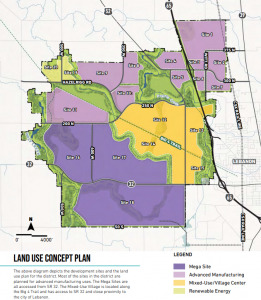Subscriber Benefit
As a subscriber you can listen to articles at work, in the car, or while you work out. Subscribe NowThe Lebanon Plan Commission on Tuesday night heard an introduction of a plan to create a special zoning classification covering part of the massive innovation district that is in the works northwest of the city.
The LEAP Lebanon Innovation District Planned Unit Development would set development standards for about 6,000 acres of the planned high-tech district in Boone County along Interstate 65 between Indianapolis and Lafayette. LEAP is an acronym for “Limitless Exploration/Advanced Pace.”
A planned unit development, or PUD, is a tool that defines and regulates proposed development and guides developers on permitted uses and design standards.
“The vision of this development is such that it is going to be a very significant economic development job generator for the next several decades,” said Aaron Kowalski, a senior associate with the Indianapolis office of landscape architecture firm MKSK, which is working the city and the Indiana Economic Development Corp. to prepare the PUD.
The property that would be rezoned as a PUD is currently zoned general industrial and single-family residential, according to the city.
The properties under consideration to be rezoned as a PUD are east of I-65, north of County Road West 300 North, west of the CSX railroad tracks and south of County Road West 375 North. Additional parcels are west of I-65, east of County Road North 500 West, north of County Road West 50 South and south of County Road West 400 North.
Scott Alexander, a lawyer representing the IEDC, told the plan commission that the PUD would not relate to areas where Indianapolis-based Eli Lilly and Co. is building a $3.7 billion manufacturing campus.
The Lebanon City Council has already approved development standards for Lilly’s campus in the LEAP district. Lilly broke ground in April on a 13-building site totaling more than 1.6 million square feet.

The Lilly campus will be bounded to the north by County Road 450 North, to the west by I-65 and to the east by the CSX railroad tracks. The campus’ southern border would be north of County Road West 300 North, which would connect to Witt Road, and County Road West 375 North.
An IEDC land-use concept plan included in Tuesday night’s presentation shows 20 different sites at the LEAP district that include uses for mega sites, advanced manufacturing, mixed-use/village center and renewable energy.
The Indiana Economic Development Corp. has identified about 11,000 acres in Boone County for the large-scale research and innovation park due to its location between Indianapolis and Purdue University and its proximity to I-65.
Lebanon has already annexed about 6,600 acres for the LEAP site.
A group of Boone County residents in January filed legal action against the city of Lebanon, accusing the municipality of violating state and local zoning law when it annexed 5,200 acres of land and created a new zoning district for the manufacturing and tech hub.
In December, the Lebanon City Council approved the creation of the LEAP zoning district. The litigation is still pending in court.
Residents will be invited to attend a community open house from 4:30 p.m.-7:30 p.m. June 29 at Lebanon City Hall where city officials will answer questions about the PUD. The PUD request will return to the plan commission on July 17 before it is introduced to the Lebanon City Council on July 24.
Please enable JavaScript to view this content.


Gonna need a bigger water pipe – and a massive diversion of the water resources that others rely upon in Indiana. This will get ugly.
Yep. I work at the DNR. This whole project has become hush hush… it’s pretty frustrating. IEDC is at wide open throttle.
IN is lucky to be getting this. Shame on the selfish idiots who are suing.
Indiana should look at the model used for the Quonset business park in Rhode Island. The state converted an old military base into an industrial park. The town it was part of created a special “Quonset” zoning classification, but the actual administration of it was left to the special board overseeing the the park development, which applied performance based standards in administering development. In other words, this state run industrial park cut local government zoning completely out of the loop. This was a big factor in the huge success of the park in contrast to the rest of the economically moribund state. It’s worth a look.